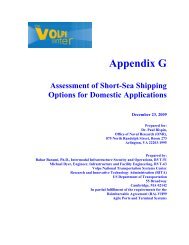ERRV Viking Islay - Marine Accident Investigation Branch
ERRV Viking Islay - Marine Accident Investigation Branch
ERRV Viking Islay - Marine Accident Investigation Branch
- No tags were found...
Create successful ePaper yourself
Turn your PDF publications into a flip-book with our unique Google optimized e-Paper software.
techniques. Such drills might also have identified that the size of the access was aproblem when wearing BA, and allowed that problem to be resolved. It is noteworthythat the extraction team that boarded the vessel from ENSCO 92 were better able tocope with the unusually small entrance as they had drilled for such an eventuality.2.6.2Command and controlThe forward control point (FCP) for the rescue was, in effect, the foredeck. Given thelimited working area inside the foc’sle store, and its proximity to the chain locker whichcontained, at that time, an unidentified hazard, this was not unreasonable. However,the hatch opening from the foc’sle store to the chain locker was the most significantphysical obstacle the rescue party had to negotiate, and the officer in-charge of theFCP, the mate, had not identified this because he could not clearly see Mr MacFadyenstruggling to get through it.Had the mate realised the difficulty Mr MacFadyen would have negotiating theentrance, wearing a breathing apparatus, he could have detailed a smaller man forthe task, or arranged for his breathing apparatus to be passed through the hatchseparately. Certainly, he would have been able to stop Mr MacFadyen attempting toenter the chain locker, wearing an EEBD.Many of the benefits to be gained from more effective training have been coveredabove. However, such training would also have allowed command and control by theperson in-charge of the FCP to be rehearsed and, where appropriate, enhanced.2.6.3EEBD limitationsMr MacFadyen had received EEBD training in the previous year, and was likely to havebeen well aware of the time-limited air supply provided by the EEBD. In a desperateattempt to rescue his shipmates, he probably took a chance with the EEBD, thinkingthat 10 minutes would be sufficient time in which to help them.However, he was unlikely to have been aware that the rate at which air was supplied tothe face mask was restricted, unlike the demand system on a breathing apparatus, andthat it was possible to ‘over breathe’ an EEBD while conducting strenuous activity.In electing to wear an EEBD rather than a BA, Mr MacFadyen took two chances withhis life. The first, that the 10 minute EEBD would last long enough to enable him tohelp the victims and then to retreat before his air supply ran out. The second, thatthe EEBD would be able to provide him with an air supply adequate for the task hefaced. For good reason, the use of an EEBD for rescues, or for otherwise entering adangerous atmosphere, is forbidden.While it is possible that the facemask became dislodged, the more likely explanation forMr MacFadyen’s collapse inside the chain locker was that, experiencing the suffocatingeffect of the restricted air supply as he climbed down into the chain locker, he removedthe EEBD face mask to take a deep breath. In doing so, he breathed in the noxiousatmosphere of the chain locker and collapsed instantaneously.Had Mr MacFadyen been able to rehearse an escape wearing an EEBD prior to thisaccident, he might have been more alert to its limitations. Then, once it was clear hecould not enter the chain locker in breathing apparatus, he might have notified theofficer in-charge of the FCP and sought an alternative plan.29
















